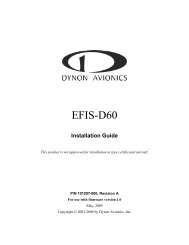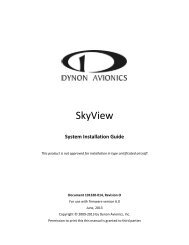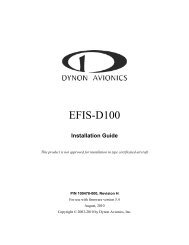Create successful ePaper yourself
Turn your PDF publications into a flip-book with our unique Google optimized e-Paper software.
SV-EMS-220 Installation and Configurationplug in the carburetor housing below the throttle valve. On four-cylinder engines which use theMarvel Schebler MA-3 carburetors, this plug is located on the forward side. On six-cylinderengines using the MA-4 carburetor, the plug is located on the rear. If your carburetor is notdrilled and tapped for the plug, you must remove the carburetor from the engine and drill outthe lead plug in the appropriate spot. Tap the hole with a ¼-28 tap. Remove all chips and burrsbefore reinstalling.Route either of the two wires to an electrical ground. Route the other wire to the generalpurpose input of your choice.Rotax CHT SensorsThe Rotax CHT sensors may be connected to any general purpose input pin on the SV-EMS-220’sDB37, however, we recommend that they be connected to pins 4 and 22 for left and rightsignals, respectively.Crimp bare ¼” female Faston terminals (6.3x0.8 according to DIN 46247) onto the ends of twogeneral purpose input wires on the EMS 37-pin Main Sensor Harness. Locate the left-side CHTsensor screwed into the bottom side cylinder head 2; slide the Faston connected to one of thegeneral purpose inputs onto it. Locate the left-side CHT sensor screwed into the bottom side ofcylinder head 3; slide the Faston connected to the other general purpose input onto it.Trim and Flaps Position PotentiometersPosition potentiometers may be connected to any general purpose input pin on the SV-EMS-220’s DB37 and must be calibrated according to the instructions found in the EMS SensorCalibration Section. The number of position potentiometers in any installation is limited by thenumber of unused general purpose input pins on the SV-EMS-220’s DB37 connector. The tablesin the Example Engine Sensor and Transducer Installations contain recommended input pins forposition potentiometers.<strong>Dynon</strong> <strong>Avionics</strong> does not sell trim or flaps position sensors. These are normally included with, oradded onto, their respective servos.Most flap and trim sensors are potentiometers (variable resistors) which require power andground inputs, and supply an output that is a function of position. These potentiometers comein a variety of resistance ranges, but are typically 1 kΩ, 5 kΩ, 10 kΩ, and 20 kΩ. All of thesevalues will work properly with the <strong>SkyView</strong>, as there is a calibration required. Connect the +5volt Auxiliary pin from the SV-EMS-220’s DB37 to the +5 volt input on your trim/flap positionsensor. Note that you may need access to the SV-EMS-220’s +5 volt auxiliary supply for othersensor installations, so make allowances for breaking out the connection to other areas.Connect the ground input on the sensor to a ground common to the SV-EMS-220’s signalground. Connect the output of the sensor to the desired general purpose input. For physicalinstallation, refer to the instructions that came with your position sensor.If you are using the output from a Ray Allen servo or sensor, connect its white/orange wire tothe SV-EMS-220’s +5 volt Auxiliary pin (DB37, pin 18), its white/blue wire to ground, and itswhite/green wire to the general purpose input of choice. Note that you may need access to the7-38 <strong>SkyView</strong> System Installation Guide - Revision J
















